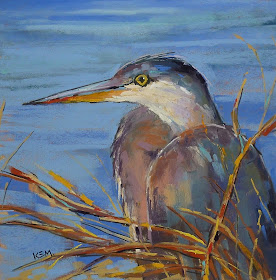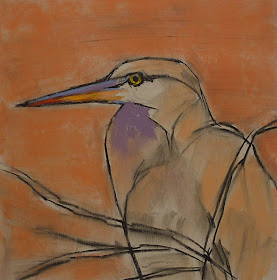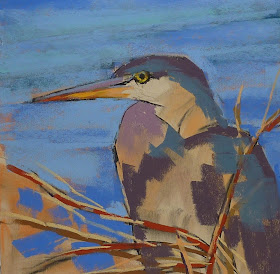 |
'Great Blue Waits' 12x12 pastel ©Karen Margulis
sold |
I was in the mood to paint a bird. I just never know what I will feel like painting when I go into my studio. Sometimes I have ideas planned and something will catch my eye and the plan goes out the window! So today was for the birds! I wanted to do another 12x12 closeup of one of my Pawleys Island birds. I chose this juvenile Great Blue Heron. (He doesn't have as much white on his head and his dark band isn't as dark as an adult)
Here are the steps I take once I decide on my paper and subject.
- I look at the photo and do a quick pencil sketch. I have to be accurate with my drawing and will measure as needed.
- Next I use a piece of compressed charcoal to redraw the bird. I just enjoy the bold lines of the charcoal so it is a personal choice to put them in.
- Now I decide how I will treat the background...I decide it will be water so I put down a thin layer of orange and blend it in. This will be the underpainting. I put some of this orange in the heron so the two areas will have some harmony.
- The first thing I paint is the heron's eye!
|
 |
| Putting in a light underpainting of orange to help harmonize the heron with the background and finishing the face |
Deciding on the background and painting the main features are important first steps. It is the eye of the bird that brings it to life. I want to be sure I get the eye right. I like to focus on the eye and beak area since it is usually the area of focus.....we are drawn to the face. It also is disconcerting to try to paint a bird with no eyes! So they go in first.
I also like to at least begin the background. First because the colors you have in the background will effect how the colors will appear in the bird so if I were to wait until the end of the painting and then throw in a background, all of the color relationships I have already established will change. I need to work on the background at the same time as the bird.
Waiting to put in the background at the end can also lead to the bird looking cut out and pasted on a background. It is hard to get them integrated. We are often too tentative around the edges of the finished bird and might even end up with a halo effect.
 |
| Midway through the painting process |
Once the features are refined and the background is started I just continue to layer colors in the heron. I work by building up each area of light, dark and middle values. I can layer several colors lightly to get more interesting color....so my heron is made up of several blues and purples and not just gray!
If you would like to paint a bird or animal using the step by step method I use you may be interested in my demo download on painting animals. The demo is a cat but the technique can be used for any animal Check out the painting demo in my Etsy shop here




Nice. Thanks for sharing your technique/steps. Will have to order the demo.
ReplyDeleteThank you Patti! I always love to read your comments. Thanks for choosing to get the demo. I hope you find it helpful!!
ReplyDelete